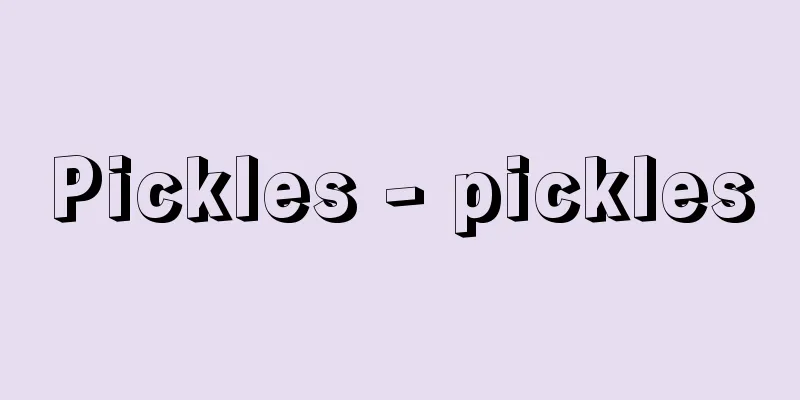Pickles - pickles

|
Crisp vegetables are pickled in vinegar with various spices. Gherkins (short cucumbers), cucumbers, small onions, cauliflower, carrots, tomatoes, beets, green beans, and peppers are salted and then pickled in vinegar with spices to improve preservation and add variety to the flavor. They are used as an accompaniment to appetizers, meat dishes, and sandwiches, as a condiment for curry sauce, or chopped and added to mayonnaise (tartar sauce) to stimulate the appetite and add variety to the flavor. Vegetables that are not fully ripe have firmer flesh and are less likely to lose their shape. For example, to make pickled cucumbers, first wash 3 kilograms of cucumbers thoroughly, drain them, and soak them overnight in boiled and cooled 10% salt water. Wash and sterilize wide-mouth glass jars, and place the salted cucumbers vertically without any gaps. In an enamel pot, add vinegar (50-25% of the cucumbers' volume (more or less to taste)) and small bags of spices (peppercorns, bay leaves, cinnamon, cardamom, cloves, chili peppers, etc.), boil, cool, and then add to the jars. Be careful not to let the cucumbers float up and come into contact with the air. Fruit vinegar and wine vinegar are delicious, but because they have a high acidity, it is best to dilute them to a 5% concentration. Also, if the vinegar is contaminated with bacteria and ferments abnormally, producing gas, it may become too acidic and become inedible, so sterilize and boil the jars carefully. Boiling vinegar in a copper or iron pot will cause the cucumbers to turn black, look unattractive, and reduce the appetite. Pickles can be eaten after one week, but are best after about six months. Pickles with dill (a fragrant herb) are called dill pickles and are popular among Westerners. Pickles made from beets and red cabbage also have a bright color, making them effective as accompaniments for appetizers, salads, sandwiches, and hamburgers. [Fumiko Kobayashi] ©Shogakukan "> Pickled cucumbers Source: Shogakukan Encyclopedia Nipponica About Encyclopedia Nipponica Information | Legend |
|
歯切れのよい野菜類を、種々のスパイスを入れた酢に漬けたもの。ガーキン(短小のキュウリ)、キュウリ、小タマネギ、カリフラワー、ニンジン、トマト、ビーツ、インゲン、ピーマンなどを塩漬けののち、香辛料とともに酢漬けにすることで保存性を高め、味に変化をつけたものである。前菜や肉料理、サンドイッチに添えたり、カレーソースの薬味や、みじん切りにしてマヨネーズに加え(タルタルソース)、食欲増進や、味に変化をつけるために用いられる。野菜は完熟していないものが身もしまり、形くずれが少ない。 キュウリのピクルスを例にあげると、まずキュウリ3キログラムをよく洗って水けを除き、沸騰後冷ました10%食塩水に一晩浸しておく。広口のガラス瓶を洗って消毒し、塩漬けキュウリをすきまなく縦に並べる。ほうろう鍋(なべ)に、酢をキュウリの50~25%(好みで増減する)量とスパイス(粒こしょう、ローレル〈ゲッケイジュの葉〉、シナモン、カルダモン、クローブ〈丁字(ちょうじ)〉、唐辛子など)を小袋に入れて加え、煮立て、冷ましたものを前記の瓶に加える。このとき、キュウリが浮き上がって空気に触れないように注意する。酢はフルーツビネガーやワインビネガーが美味であるが、酸度が高いので5%濃度に薄めて用いるとよい。また、雑菌の混入によって異常発酵してガスを発生したものは、酸度があがりすぎて食用不可能になることがあるので、瓶の消毒と煮沸はていねいに行う。銅や鉄の鍋で酢を煮立てたものは、キュウリの仕上がりが黒ずんで見かけが悪く、食欲を減退させる。ピクルスは漬けて1週間後から食べられるが、半年ぐらいまでがおいしい。 ディル(香草)を加えたものはディルピクルスとよばれ、欧米人に好まれる。また、ビーツや赤キャベツのピクルスは鮮やかな色になるので、前菜、サラダ、サンドイッチ、ハンバーガーなどの添え物に効果的である。 [小林文子] ©Shogakukan"> キュウリのピクルス 出典 小学館 日本大百科全書(ニッポニカ)日本大百科全書(ニッポニカ)について 情報 | 凡例 |
Recommend
Cao Shi - Zoshi
〘Noun〙① In the Nara and Heian periods, a main offi...
Caracciolo, D.
...From this time on, Sicily came under the rule ...
Khanty (English spelling)
Formerly called the Ostyak people, they call thems...
iron ship
…a ship whose hull is made of steel. It is distin...
Kasumi salamander - Kasumi salamander
A salamander of the order Caudata, class Amphibia...
Glykophilousa
...The great development of the iconography occur...
Matsushiro Domain
This clan ruled over northern Shinano, with its h...
Pheretial earthworm (large earthworm) - Pheretial earthworm
A general term for annelids belonging to the famil...
Hayashikotoba - Hayashikotoba
〘 noun 〙 A meaningless word that is inserted in or...
School stirrups - student
A reading magazine published by Maruzen. It is the...
Epoche - Greek
The original Greek meaning of epoche is "to ...
Sardine acid - Iwashi-san
→ Clupanodonic acid Source: Asakura Publishing Nut...
Nojimazaki
A cape located in the Shirahama district of Minam...
Indirect measurement
Please see the "How to Measure" page. S...
Karāva (English spelling)
…Unlike India, the Sinhalese caste system does no...









